I’m not a big “no-global” proponent; so if someone in, say, Vermont, is making great ice cream, I think it should be shared with the rest of the world. Therefore, when Ben & Jerry’s (full disclosure: I have eaten hundreds of pints of B&J’s in my lifetime) was scheduled to open a store in Florence that wasn’t a major issue for me.
But when that storefront is just a few feet from the façade of the Duomo and my favorite flavors (Vanilla Heath Bar Crunch and Triple Caramel Chunk,) of the Vermont ice cream have turned in to a frozen substance made by Unilever in Holland, renamed Caramel Chew Chew and Vanilla Toffee Crunch (because evidently there are no Heath Bars in Europe), then I’m just a little bit burnt to a crisp under this Tuscan sun.
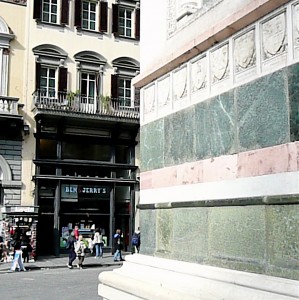
Ice cream is an important part of the American culture, but here in Italy, it is a religion. On a weekly basis more Italians enter a gelateria than a church. They argue about gelato more than religion, too. Florentines, especially, can debate long and hard about their favorite gelateria: describing the benefits of local gelato-masters vs. the new “foreigners” (from Turin or Bologna or Sicily); asserting that creamy cioccolato fondente is better than cioccolato extra noir that lacks both eggs and cream; and despairing that not only do foreigners commit the sins of eating semifreddo in the summer, granita in the winter, but the tourists also request a 5 euro cone (way too big) from any so-called gelato stand that stacks the factory-made blocks of ice cream, sculpts them into a hill, and drapes fruit all over the mountainous mass.
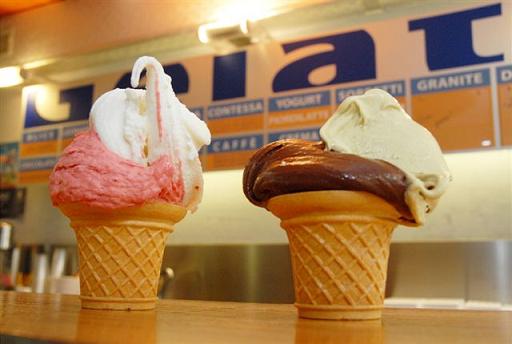
‘Gelato’ means ‘partially frozen’ or “icy” in Italian and the various kinds of ice cream served throughout the country are all known by that name. You can order gelato in any little town, in any region and basically know what you will get. But it is important to keep in mind that Italy has only been a unified country for 150 years, so each of the former city states is justifiably proud of its own recipe: in the mountainous North, where it’s cooler, the gelato is thicker and creamier, often made with cream and egg yolks – chocolate, zabaione, and hazelnuts prevail. In the South, the gelato tends to be lighter, using milk as well as and fruits, such as Sorrento lemons, and nuts, like Sicilian pistacchios from Bronte.
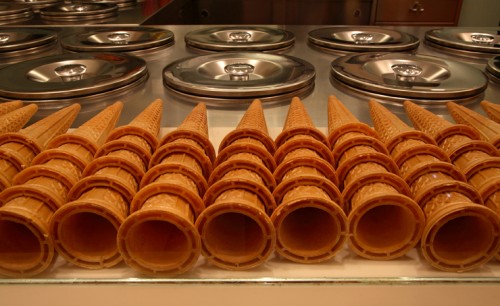
Florentines have had a 500-year love affair with gelato. Bernardo Buontalenti – architect, engineer and theatrical set designer – supposedly invented churned-over-ice, milk-based gelato for the court of Francesco de’ Medici to impress a visiting Spanish delegation in 1565. Today, there is a rich creamy gelato that bears Buontalenti’s name.
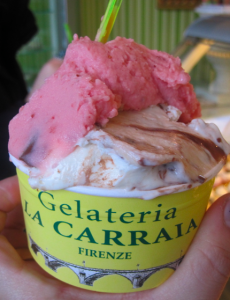
But getting back to Ben & Jerry’s … it’s one of America’s premium ice creams. If gelato is Italian ice cream, what is the difference? First of all, there is the percentage of butterfat. B&J’s clocks in at around 17%, whereas most Italian gelato averages 5% to 9%. Also, handcrafted gelato is served same-day fresh so binders and preservatives aren’t necessary.
But there’s more … David Lebovitz, chocolate maven and world-reknown ice cream aficionado, author of The Perfect Scoop, explains it best. “… for the most part, the machines used to make gelato move very slowly as they churn, introducing little air into the mixture so the finished gelato is dense and thick. Unlike standard ice cream-making machines, usually the ‘dasher’ (paddle) moves up and down while the canister turns, so little air is whipped into the mixture while it churns. Also the storage freezers used for holding gelato tend to be kept a few degrees warmer (up to 10 degrees F) than a normal ice cream dipping cabinet, so the gelato keeps its silky, creamier texture. Sometimes there are no egg yolks or cream in the base, so the gelato will highlight the highly-concentrated taste of what’s been added, like chocolate, coffee, or whatever flavoring is used, with less taste and texture of fat to intrude.”
Okay, so now you know what gelato is, but what happens when you walk into a Florentine gelateria? Yes, there is a lot of gelato, but you also see semifreddo, sorbetto, and granita. Generally these are all classified as gelato … remember? … frozen/icy. Here is a handy guide:
gelato – most everything offered, but there is also …
semifreddo – means “half cold” and is made from the same base as gelato, but has whipped cream folded in to create a frozen mousse.
sorbetto – is a sorbet, usually made with any kind of fruit, but chocolate and caffé flavors are making a strong showing, as well as herb-infused (basil, rosemary, etc.) offerings. Great as a palate cleanser between courses in an extended multi-course meal.
granita – shaved ice, made with water, sugar and fruit flavors – strawberry and lemon are favorites – or coffee (great with a dab of whipped cream), mint or almonds. Served in a plastic cup or glass, but also on brioche in Sicily in the summertime.
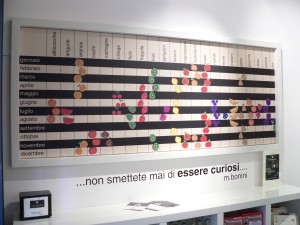
Tuscan Traveler joins the debate by claiming that not only does Florence have the best gelato in Italy, but that these are the best gelaterias in Florence:
Grom – Via del Campanile – corner with Via delle Oche – Piedmonte-based, consistently great, only the best ingredients, innovative, monthly flavor list online, best cone. Try: Zabaione, Crema di Grom, and Caffè
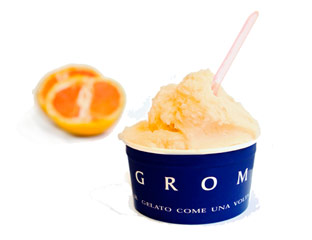
Gelateria La Carraia – Piazza Nazario Sauro, 25r – Ponte alla Carraia – owned by the Florentine Innocenti family, creamiest gelato, best tangy yogurt, one euro cone heaped high (best value). Try: Yogurt, Pistacchio, and Nutella
RivaReno – Borgo degli Albizi 46r – newcomer (owners rumored from Milan and Great Britain?), most innovative mix-ins, great fresh fruit flavors, good cone. Try: Lampone (raspberry), Otello ( chocolate with zabaione, brownie, and coffee), and Sweet Alabama (chocolate with peanuts).
Perché No? – Via dei Tavolini 19r – best name, traditional favorite (started in 1938, surviving war and flood), fresh fruit and nut flavors, best semifreddo. Try: Stracciatella (chocolate chip), Cioccolato Semifreddo, and Nocciola (hazelnut)
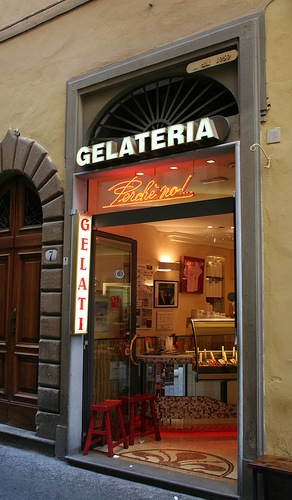
Gelateria dei Neri – Via dei Neri 22r – long-time Florentine owner, fantastic fruit flavors, creamy yogurt, best variety of chocolate flavors. Try: Chocolate with candied orange, Chocolate with hot red pepper, and Mandarino (tangerine)
Carabé – Via Ricasoli 60r – Sicilian owners, delicious fruit and nut flavors (ingredients brought from Sicily), best granita. Try: Cassata Gelato, Lemon and Raspberry Granita together, and Coffee Granita with whipped cream.
Carapina – Via Lambertesca 118r – young Florentine owner, trendiest, posts a calendar of ripe fruit and only makes those flavors when they are at their peak. Try: Menta (mint), Ciliegia (cherry), and Chocolate with ginger.
Vestri – Borgo degli Albizi 11r – superb chocolate shop with the best chocolate gelato and incredible thick hot chocolate (served cold in the summer) – mix the two for affogato (gelato drowned in chocolate). Try: Affogato with Chocolate, Pistacchio or Vanilla gelato.
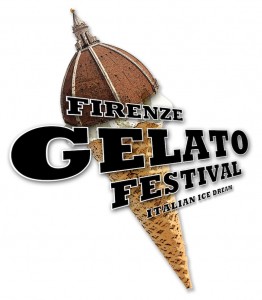
Those visiting Florence at the end of May are in for a treat. The First Annual Firenze Gelato Festival will turn Piazza S. Annuziata into a giant gelateria where artisans of the handcrafted gelato will compete for the hearts and taste buds of Florentines and foreigners from May 28 to 31, 2010.
